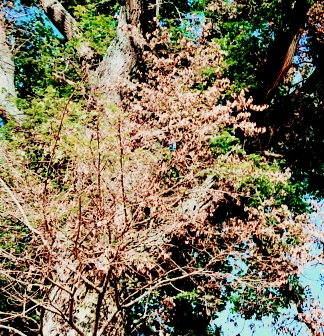PESTS AND DISEASES OF FORESTRY IN NEW ZEALAND
Dutch elm disease under control
From Biosecurity issue 21, August 2000.
After 10 years of continuous response actions it appears that Dutch elm disease is now under control in New Zealand and could soon be eliminated.

No country in the world has ever managed to eradicate Dutch elm disease, which is specific to elm trees and is directly responsible for the death of the majority of elms in the United States and Europe. Continually encouraging survey results now indicate that New Zealand could be the first to successfully eliminate the disease. “Dutch elm disease is being controlled in New Zealand, and a successful conclusion to the 10-year response programme is now a distinct possibility”, says Dr Ruth Frampton, Director Forest Biosecurity.
First detected in Auckland
In the summer of 1993/94, Dutch elm disease was discovered in Sturm’s Gully, Napier. The Napier occurrence was unusual in that there was no evidence of the vector beetle that carried the fungus. The disease had spread through the gully in root grafts from adjacent trees. In 1997, about 200 elm trees were removed and destroyed.
Monitoring in Sturm’s Gully continues with no infections being detected.
Dutch elm disease was first reported in central Auckland in December 1989. As a result of the detection, the then Ministry of Forestry initiated a response involving the removal and destruction of infected elms. Restrictions were put in place, still valid today, prohibiting the movement of any produce of elm trees from or into the greater Auckland area. Ongoing surveys were conducted and a database was designed to assist in the monitoring of all known elm locations in the area.
Bark beetle, the disease vector
The spread of the disease in Auckland has largely been attributed to the introduced bark beetle Scolytus multistriatus, which carries the fungus from diseased trees to other elms when it feeds. The beetle flies during the summer months, particularly in high temperatures.
Dutch elm disease strikes quickly once infection sets in. The fungi Ophiostoma ulmi and Ophiostoma
novo-ulmi cause the disease that spreads rapidly throughout the elm tree, killing it within one year. Infected trees wilt, and eventually die, as the water-conducting tissues in the branches and trunks become clogged. Visible signs of the disease are wilting branches with curled yellow or brown leaves falling from the tree prematurely.
A pheromone trapping system for the vector was established in the 1990/91 season. Capture of the spore-carrying beetles assisted in determining the distribution of Dutch elm disease. The disease is also known to spread through root grafting or transportation of infected elm material such as firewood.
Decline in disease

For nine years, the annual Dutch elm disease programme involved three disease detection surveys of all recorded elm locations in Auckland, vector pheromone trapping and removal of infected trees. During that period, disease levels declined with no “new” infected tree locations detected during the 1996/97, 1997/98 and 1998/99 seasons.
Due to the reduced disease levels, beetle trapping was discontinued for the 1999/00 season and an “asymptomatic” (contained infection) survey was initiated to determine the incidence of the fungus within the inner growth rings of elm trees.
It is intended that, over a five-year period, all elm trees in the greater Auckland area will be tested for contained infection. At the end of this period, given that any tree with asymptomatic infection will be destroyed, MAF hopes to conclude that Dutch elm disease has been eradicated from New Zealand.
Mark Ross, National Adviser, Forest Pest Surveillance and Response, MAF Forest Biosecurity

 Farm Forestry New Zealand
Farm Forestry New Zealand

